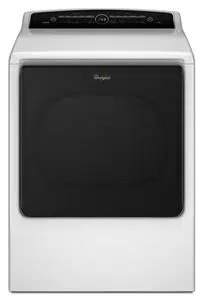Documents: Go to download!
User Manual
- User Manual - (English, French)
- Dimension Guide - (English)
- Installation Instruction - (English)
- Installation Instruction - (English)
- Warranty - (English)
- CHECK YOUR VENT SYSTEM FOR GOOD AIRFLOW
- CONTROL PANEL AND FEATURES
- CYCLE GUIDE
- USING YOUR DRYER
- ADDITIONAL FEATURES
- DRYER CARE
- TROUBLESHOOTING
Table of contents
User Manual Dryer
CHECK YOUR VENT SYSTEM FOR GOOD AIRFLOW
Good airflow
Along with heat, dryers require good airflow to efficiently dry laundry. Proper venting will reduce your drying times and improve your energy savings. See Installation Instructions. The venting system attached to the dryer plays a big role in good airflow. Blocked or crushed vents as well as improper venting installation will reduce airflow and dryer performance.
Service calls caused by improper venting are not covered by the warranty and will be paid by the customer, regardless of who installed the dryer. To clean or repair venting, contact a venting specialist.
Maintain good airflow by:
- Cleaning your lint screen before each load.
- Replace plastic or foil vent material with 4" (102 mm) diameter heavy, rigid vent material.
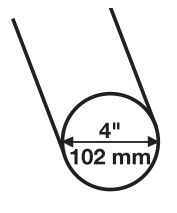
- Use the shortest length of vent possible.
- Use no more than four 90° elbows in a vent system; each bend and curve reduces airflow.
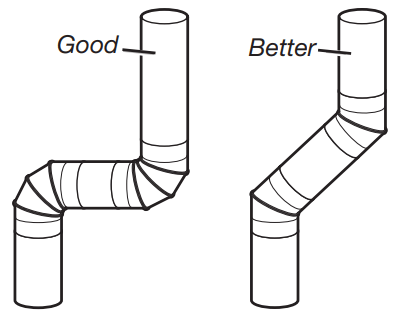
- Remove lint and debris from the exhaust hood.
- Remove lint from the entire length of the vent system at least every 2 years. When cleaning is complete, be sure to follow the Installation Instructions supplied with your dryer for final product check.
- Clear away items from the front of the dryer.
EcoBoost™ option
Touch to activate the EcoBoost™ option, which allows you to increase your energy savings by using a slightly lower heat level. For automatic cycles, the EcoBoost™ option will increase drying times by approximately 40 minutes; the LED Display will reflect this time.
The EcoBoost™ option will default on for Normal. For optimal energy, turn on the EcoBoost™ option. For optimal time, turn off the EcoBoost™ option.
What To Dry and How To Dry? for better fabric care and energy savings.
By answering these questions, you can achieve the most energy savings and enhanced fabric care from your dryer. Using these automatic cycles, the drying air temperature and moisture levels are sensed in the load. This sensing process occurs throughout the entire drying cycle and turns off once the load reaches your selected dryness level. Using the NORMAL dryness level provides optimal energy savings.
If Timed Dry is your answer, the dryer runs for the amount of time you select, which sometimes results in shrinkage, wrinkling, and static due to over-drying. Use Timed Dry for the occasional damp load that needs a little more drying time or when using the drying rack.
Tips for getting the best performance from your steam dryer (on some models)
- Results may vary depending on fabric. 100% cotton garments with wrinkle-free finish may yield better results than those without. 100% cotton items may require additional touching up after cycles that use steam.
- Use of fabric softener sheets is not recommended with cycles that use steam. It may cause temporary staining on clothes.
- Cycles that use steam are not recommended for items that have been starched. Wash any starched or new garments prior to using a cycle that uses steam.
- The Steam Refresh Cycle is best for smoothing out wrinkles and reducing odors from loads consisting of dry items of wrinkle-free cotton, cotton-polyester blend, common knits, and synthetics.
CONTROL PANEL AND FEATURES
STEAM MODELS
NOTE: The control panel features a sensitive surface that responds to a light touch of your finger. To ensure your selections are registered, touch the control panel with your finger tip, not your fingernail. When selecting a setting or option, simply touch its name.
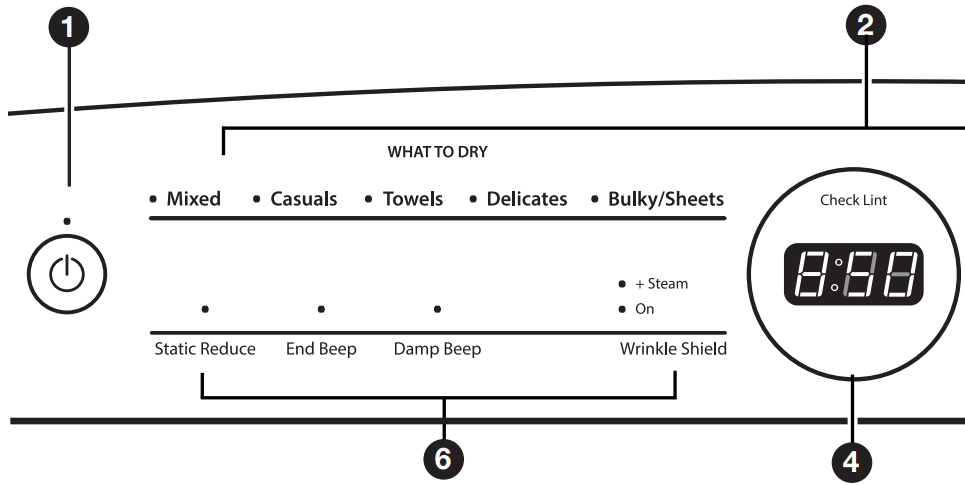
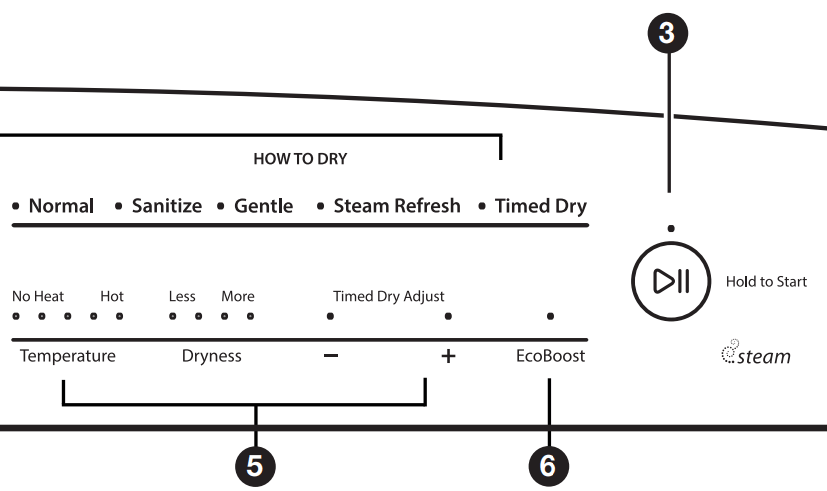
NON-STEAM MODELS
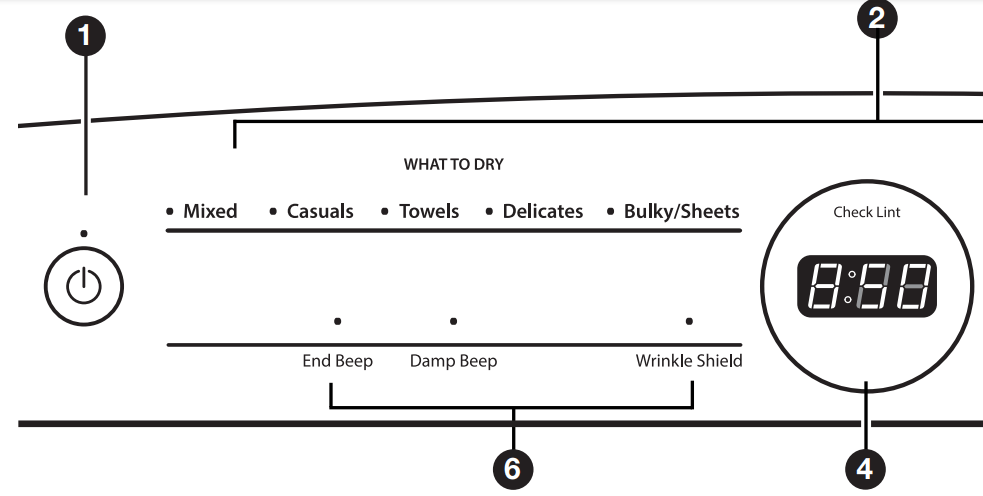
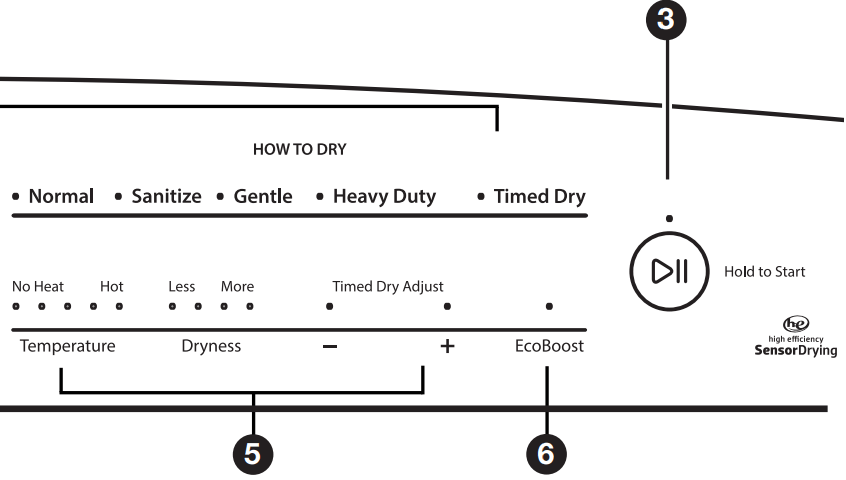
1. POWER
Touch to turn the dryer on and off. Touch to stop/cancel a cycle at any time.
2. WHAT TO DRY/HOW TO DRY
First, select a cycle from the “What to Dry” (Automatic cycles) and then select the “How to Dry” to get the best combination cycle available for the type of items you are going to dry. See “Cycle Guide” for cycle details.
3. START/PAUSE
Touch and hold until the LED comes on to start a cycle, or touch once while a cycle is in process to pause it.
4. LED DISPLAY
When you select a cycle, its default settings will light up and the Estimated Time Remaining (for Automatic Cycles) will vary depending on “What to Dry” and “How to Dry” selections or actual time remaining for Timed Dry cycles (for Manual Cycles) will be displayed
5. MODIFIERS
Use to select available modifiers for your dryer. Not all cycles and options are available on all models.
Temperature
When using Timed Dry Cycle, you may select a dry temperature based on the type of load you are drying. Use the warmest setting safe for the garments in the load. Follow garment label instructions.
NOTE: Automatic Cycles will give you up to 3 temperatures to adjust and it varies, depending on the “What to Dry” or “How to Dry” selections that have been made.
Dryness
You may adjust the Dryness on Automatic Cycles (except for the Sanitize cycle), if desired.
NOTE: Dryness is for use with Automatic Cycles only.
+\- Timed Dry Adjust
Touch “+” or “–” with Timed Dry cycle to increase or decrease the length of the cycle.
6. OPTIONS
Use to select available options for your dryer. Not all cycles and options are available on all models.
Static Reduce (on some models)
Touch to add the Static Reduce option to selected Automatic cycles. The dryer will automatically tumble, pause, and introduce a small amount of moisture into the load to help reduce static. This option adds approximately 8 minutes to the total cycle time.
End Beep
Use this to turn the signal indicating the end of a drying cycle to low, medium, high, or off.
NOTE: You may also turn off the tones that sound when a feature, setting, or option is touched. Touch and hold End Beep for about three seconds to turn sounds to low, medium, high, or off.
Damp Beep
Touch to select the Damp Beep signal. You may adjust the signal to low, medium, high, or off. When selected, a series of beeps will sound when the load is damp, but not completely dry. This will allow you to take clothes out of the load that do not need to dry completely. This option is available on some cycles. The Damp Beep signal is selected as a default for the Bulky/Sheets cycle, as a reminder to manually reposition bulky loads midway through the cycle.
Wrinkle Shield™ Option
If you will be unable to remove a load immediately, touch Wrinkle Shield™ to add up to 150 minutes of periodic tumbling to help reduce wrinkling. You may select the “+ Steam” setting (on some models) to add a short steam cycle after 60 minutes to help smooth out wrinkles.
NOTE: If you open the dryer door prior to the end of the Wrinkle Shield™ option, the dryer will go into Pause mode. You will need to touch Power to turn off or touch Start/Pause to continue Wrinkle Shield™ option.
EcoBoost™ Option
Touch to activate the EcoBoost™ option, which allows you to increase your energy savings by using a slightly lower heat level. This will increase dry times. EcoBoost™ option will default on for Mixed Normal. Can be selected for: Mixed Gentle, Casual Normal, Casual Gentle, Delicate Normal, and Delicate Gentle. It will be not available for the other cycles.
Steam Refresh (steam models only)
This cycle is best for reducing wrinkles and odors from dry items. Cycle time will increase depending on number of items.
CYCLE GUIDE
Steam Model
The Whirlpool® Cabrio® dryer has a unique user interface to help you select the best cycle you need for your load. The “What to Dry” “How to Dry” layout guides you to the optimal cycle in two easy steps: First determine what items are in the load that you are trying to dry. Use that to guide your “What to Dry” selection. Then determine how you want the dryer to dry them by selecting the appropriate “How to Dry” selection. To get the most energy savings and enhanced fabric care from your dryer, use the Automatic cycles. These cycles measure the drying air temperature and moisture levels to turn the dryer off once the load reaches the selected dryness level. Dryer performance and results may vary with service voltage less than 240.
For best fabric care, choose the cycle that best fits the load being dried.
R - Recommended Cycle
a - Alternate Cycle Blank – Cycle is available but not optimal.
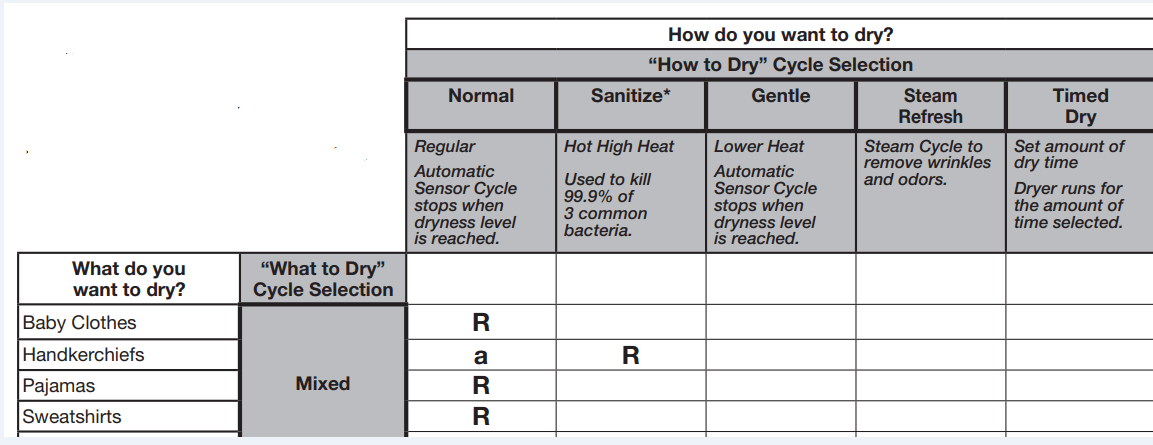

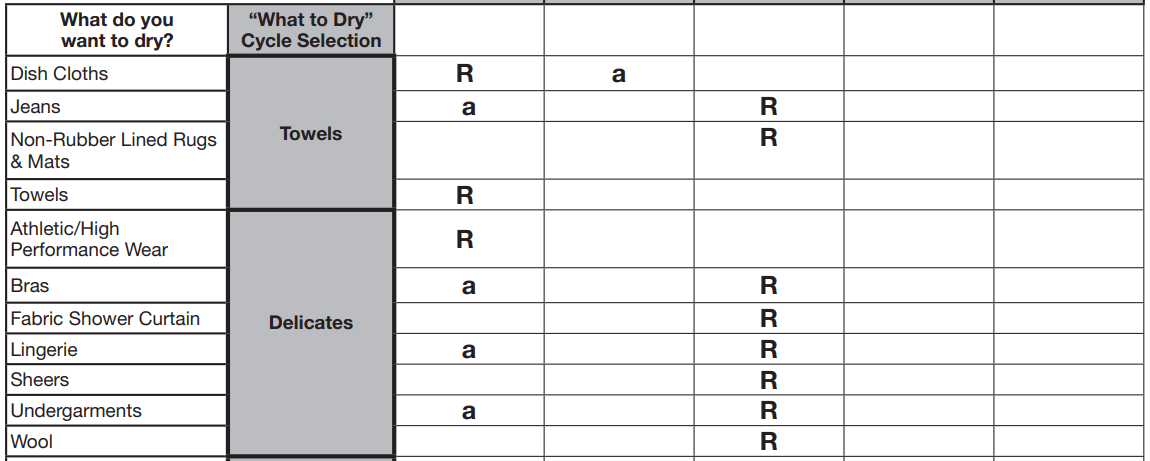
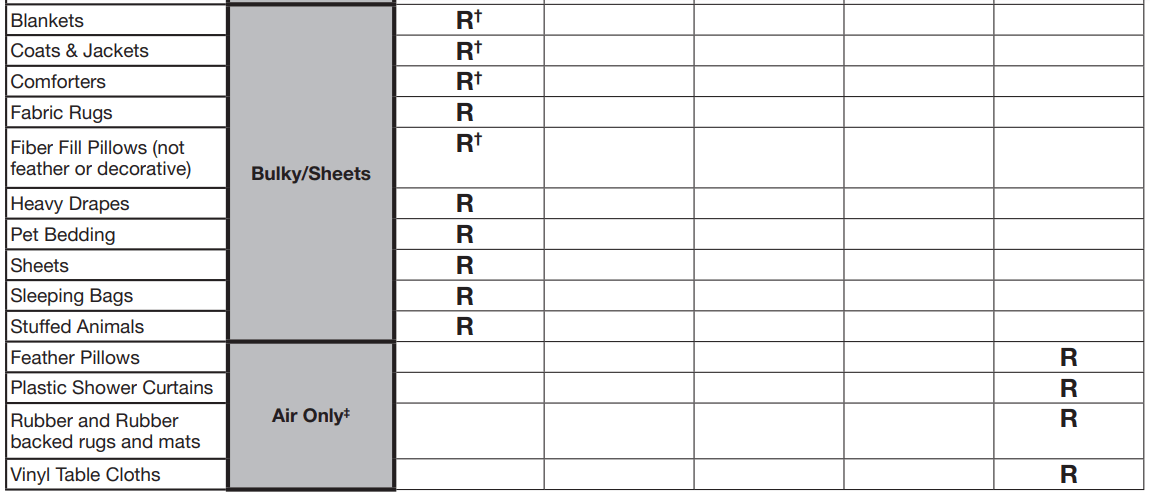
*Extended high-heat drying cycle intended to help sanitize items such as sheets and towels. This cycle is not recommended for all fabrics. For best results, this cycle should be run to completion to ensure sanitization and do not interrupt cycle.
† For best results, change the Temperature and Dryness levels to their highest settings.
‡ Air Only is not a “What to Dry” cycle selection. To get Air Only, select Timed Dry and set Temperature to No Heat.
Non-Steam Model
The Whirlpool® Cabrio® dryer has a unique user interface to help you select the best cycle you need for your load. The “What to Dry” “How to Dry” layout guides you to the optimal cycle in two easy steps: First, determine what items are in the load that you are trying to dry. Use that to guide your “What to Dry” selection. Then determine how you want the dryer to dry them by selecting the appropriate “How to Dry” selection. To get the most energy savings and enhanced fabric care from your dryer, use the Automatic cycles. These cycles measure the drying air temperature and moisture levels to turn the dryer off once the load reaches the selected dryness level. Dryer performance and results may vary with service voltage less than 240.
For best fabric care, choose the cycle that best fits the load being dried.
R - Recommended Cycle
a - Alternate Cycle Blank – Cycle is available but not optimal.
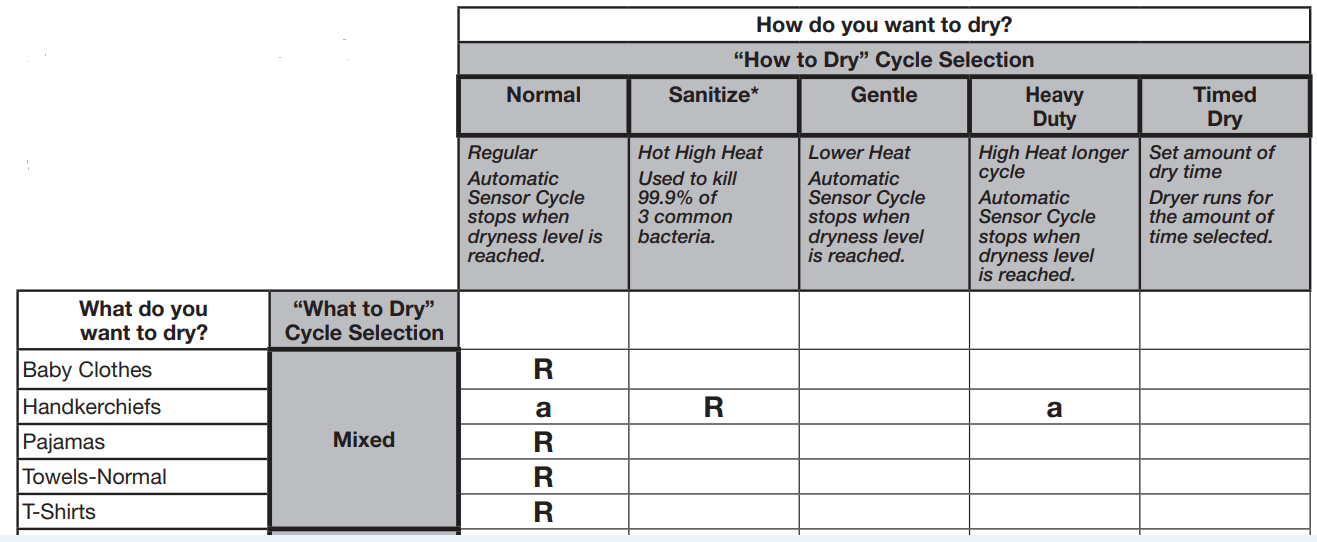


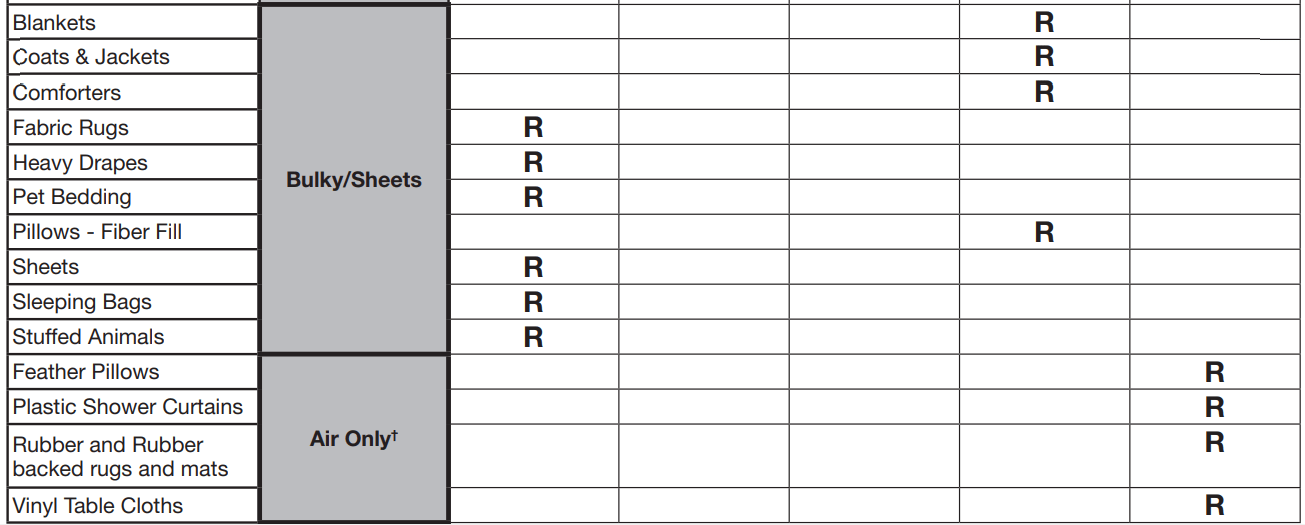
*Extended high-heat drying cycle intended to help sanitize items such as sheets and towels. This cycle is not recommended for all fabrics. For best results, this cycle should be run to completion to ensure sanitization and do not interrupt cycle.
† Air Only is not a “What to Dry” cycle selection. To get Air Only, select Timed Dry and set Temperature to No Heat.
USING YOUR DRYER
1. Clean the lint screen
Clean the lint screen before each load. Pull the lint screen straight up and push tab down on front to open lint screen. Roll lint off the screen with your fingers. Do not rinse or wash screen to remove lint. Wet lint is hard to remove. Close lint screen and push the lint screen firmly back into place. For additional cleaning information, see “Dryer Care.”
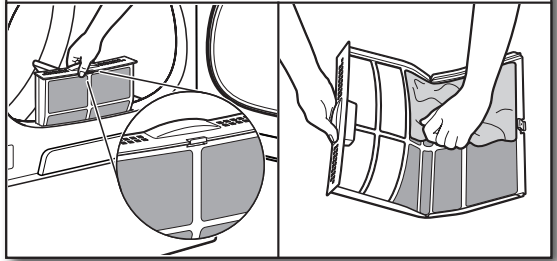
2. Load the dryer
Open the door by pulling on the handle. Place laundry in the dryer. Add a dryer sheet to wet load, if desired. Close the door.
IMPORTANT: Do not tightly pack the dryer. Items need to tumble freely. Tightly packing can lead to poor drying performance and may increase wrinkling and tangling.
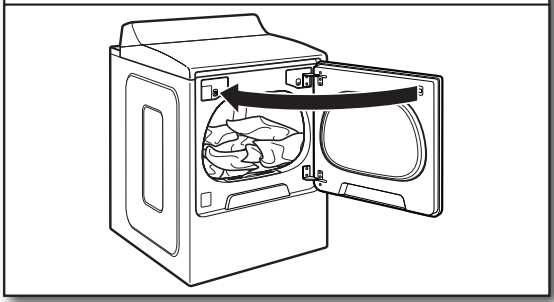
3. Touch POWER
Touch POWER to turn on the dryer

4. Select type of load to dry
First, select a cycle from the “What to Dry” (Automatic cycles) and then select the “How to Dry” to get the best combination cycle available for the type of items you are going to dry. See “Cycle Guide” for cycle details. Not all cycles are available on all models.
Automatic Cycles:
You can select a different dryness level, depending on your load. Touch DRYNESS to scroll to Less to More. Selecting Less to More automatically adjusts the dryness level at which the dryer will shut off. Dryness level can be changed in the first 5-8 minutes of the cycle.
Automatic Cycles give the best drying in the shortest time. Drying time varies based on fabric type, load size, and dryness setting.
NOTE: Automatic Cycles will give you up to 3 temperatures to adjust and it varies, depending on the “What to Dry” or “How to Dry” selections that have been made.
TIMED DRY Cycle:
When you select Timed Dry, the default time appears in the display. Touch “+” and “–” to increase or decrease the time in 1-minute increments. Touch and hold to change the time in 5-minute increments.
The default temperature may be changed by pressing Temperature until the desired dry temperature is lit.
Steam Refresh Cycles (on some models):
Select Steam Refresh to reduce odors and light wrinkles in dry loads consisting of wrinkle-free cotton, cotton-polyester blends, common knits, and synthetics. If you will be unable to remove a load immediately, touch Wrinkle Shield™ to add up to 150 minutes of periodic tumbling. You may select the + Steam setting to add a short steam cycle after 60 minutes to help smooth out wrinkles.
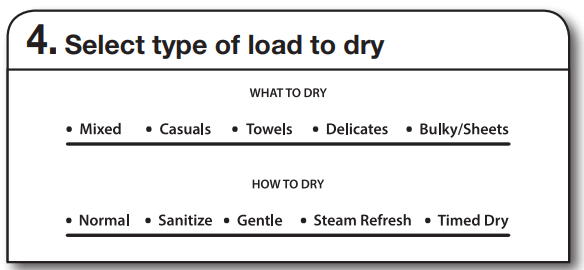
5. Adjust cycle modifiers, if desired
You may adjust different settings, depending on what you are drying and how you are going to dry the item. See the “Cycle Guide” for detailed information.
NOTE: Not all options and modifiers are available with all cycles. Not all cycles are on all models.
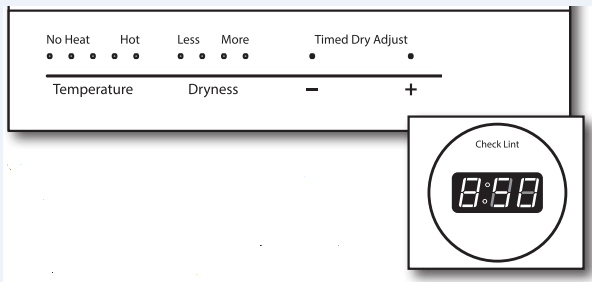
6. Select any additional options
Add additional options such as Static Reduce, Wrinkle Shield, and/or EcoBoost™ (on some models) by touching that option. If you will be unable to remove the load promptly, select Wrinkle Shield™ before pressing START/PAUSE. You may select the “+ Steam” setting (on some models) to add a short steam cycle after 60 minutes to help smooth out wrinkles.
NOTE: Not all options and settings are available with all cycles

7. Touch and hold START/PAUSE to begin cycle
Touch and hold START/PAUSE to begin the cycle.

8. Remove garments promptly after cycle is finished
Promptly remove garments after cycle has completed to reduce wrinkling.
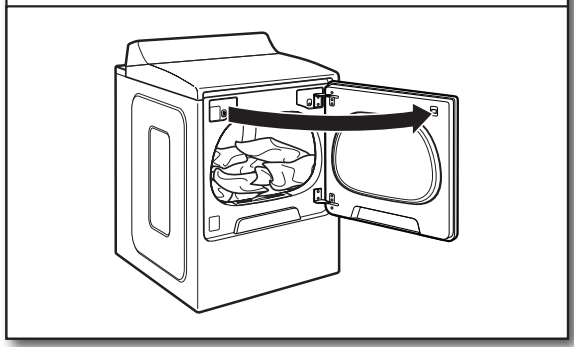
Changing the Automatic Cycle settings to increase or decrease drying time
If all your loads on Automatic Cycles are consistently less dry or drier than you would like, you may change the default settings to increase or decrease the default dryness level.
Your automatic drying settings can be adjusted to adapt to different installations, environmental conditions, or personal preferences. This change is retained and will affect all of your Automatic Cycles, not just the current cycle/load. There are 5 drying settings, which are displayed using the time display:
0 Much wetter clothes, 30% less drying time.
1 Slightly wetter clothes, 15% less drying time.
2 Factory preset dryness level.
3 Slightly drier clothes, 15% more drying time.
4 Much drier clothes, 30% more drying time.
To change the drying settings:
NOTE: The settings cannot be changed while the dryer is running or paused. The dryer must be in standby mode (power is off) to adjust the default settings.
1. Before starting a cycle, touch and hold DRYNESS for 6 seconds.
2. Touch DRYNESS to select the dryness level shown in the time display: 0, 1, 2, 3, or 4.
3. Touch START/PAUSE to save the new dryness level setting.
ADDITIONAL FEATURES
USING THE DRYING RACK
To obtain a drying rack for your dryer, order by calling 1-877-944-7566. You will need your model and serial number and the purchase date. Remove and discard any packing material before use.
Use the Drying Rack for items that you do not want to tumble dry, such as sweaters and tennis shoes. When you use the drying rack, the drum continues to turn, but the rack remains stationary.
The drying rack is intended for use with the Manual Dry/ Timed Dry cycles only. The drying rack cannot be used with Automatic cycles.
To use the drying rack:
IMPORTANT: Do not remove the lint screen.
1. Open dryer door.

2. Align the two hooks on the front of the drying rack with the holes in the dryer door opening and press down fully into holes. Rest the rear support on the dryer back ledge
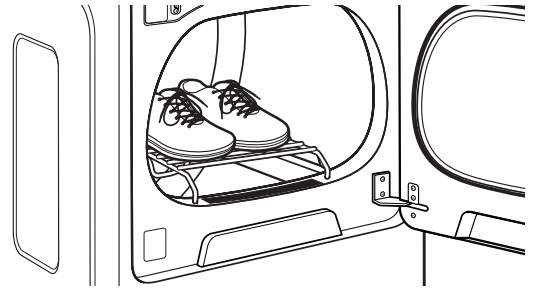
3. Place wet items on top of the drying rack. Allow space around items for air to circulate. The drying rack does not move, but the drum will rotate; be sure to leave adequate clearance between items and the inside of the dryer drum. Make sure items do not hang over the edges or between drying rack grille.
4. Close the door.
5. Select a Timed Dry/Air Only or Low-Temperature cycle. Items containing foam, rubber, or plastic must be dried on a clothesline or by using the Air Only setting.
6. When the cycle is selected, the Estimated Time Remaining display shows the default time. You can change the actual time in the cycle by increasing or decreasing the cycle time.
7. Start the dryer.
DRYER CARE
CLEANING THE DRYER LOCATION
Keep dryer area clear and free from items that would block the air flow for proper dryer operation. This includes clearing piles of laundry in front of the dryer.
CLEANING THE DRYER INTERIOR
To clean dryer drum
1. Use a mild hand dish detergent mixed at a low concentration with very warm water, and rub with a soft cloth.
2. Rinse well with a wet sponge or towel.
3. Tumble a load of clean clothes or towels to dry drum
OR
Use a microfiber cloth and hot water in a spray bottle to clean the drum and a second microfiber towel to dry
REMOVING ACCUMULATED LINT
From Inside the Dryer Cabinet
Lint should be removed every 2 years, or more often, depending on dryer usage. Cleaning should be done by a qualified appliance servicer or ventilation system cleaner.
From the Exhaust Vent
Lint should be removed every 2 years, or more often, depending on dryer usage.
CLEANING THE LINT SCREEN
Every load cleaning
The lint screen is located in the door opening of the dryer. The control panel has an indicator light “Check Lint” to remind you to clean the lint screen after each load. A screen blocked by lint can increase drying time.
To clean:
1. Pull the lint screen straight up. Press tab down and open lint screen. Roll lint off the screen with your fingers. Do not rinse or wash screen to remove lint. Wet lint is hard to remove.
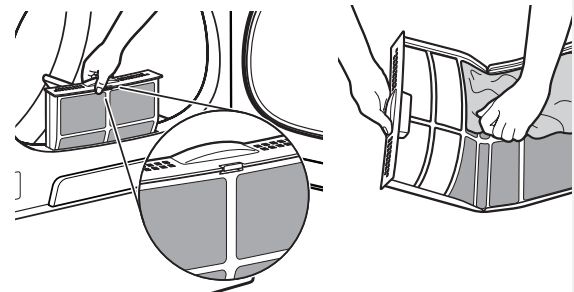
2. Close the lint screen and push it firmly back into place.
IMPORTANT:
- Do not run the dryer with the lint screen lost, damaged, blocked, or missing. Doing so can cause overheating and damage to both the dryer and the fabrics.
- If lint falls off the screen into the dryer during removal, check the exhaust hood and remove the lint. See “Venting Requirements” in the Installation Instructions.
- Clean space where lint screen is located, as needed. Using a vacuum, gently remove any lint that has accumulated outside of the lint screen.
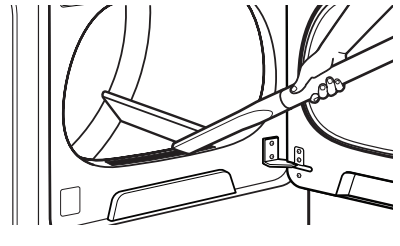
As needed cleaning
Laundry detergent and fabric softener residue can build up on the lint screen. This buildup can cause longer drying times for your clothes, or cause the dryer to stop before your load is completely dry. The screen is probably clogged if lint falls off while the screen is in the dryer. Clean the lint screen with a nylon brush every 6 months, or more frequently, if it becomes clogged due to a residue buildup.
To wash:
1. Roll lint off the screen with your fingers.
2. Wet both sides of lint screen with hot water.
3. Wet a nylon brush with hot water and liquid detergent. Scrub lint screen with the brush to remove residue buildup.
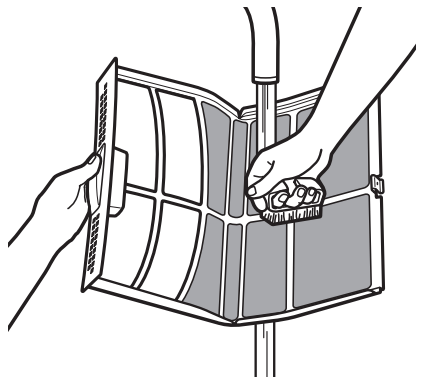
4. Rinse screen with hot water.
5. Thoroughly dry lint screen with a clean towel. Reinstall screen in dryer.
NON-USE, STORAGE, AND MOVING CARE
Steam models only: Install and store your dryer where it will not freeze. Because some water may stay in the hose, freezing can damage your dryer. If storing or moving your dryer during freezing weather, winterize it.
Non-Use or Storage Care
Operate your dryer only when you are at home. If you will be on vacation or not using your dryer for an extended period of time, you should:
1. Unplug dryer or disconnect power.
2. Clean lint screen. See “Cleaning the Lint Screen.”
3. Turn off the water supply to the dryer. This helps to avoid unintended flooding (due to a water pressure surge) while you are away.
Moving Care
For power supply cord-connected dryers:
1. Unplug the power supply cord.
2. Gas models only: Close shut-off valve in gas supply line.
3. Gas models only: Disconnect gas supply line pipe and remove fittings attached to dryer pipe.
4. Gas models only: Cap the open fuel supply line.
5. Steam models only: Shut off water faucet.
6. Disconnect the water inlet hose from faucet, then drain the hose. Transport hose separately.
7. Make sure leveling legs are secure in dryer base.
8. Use tape to secure dryer door.
For direct-wired dryers:
1. Disconnect power.
2. Disconnect wiring.
3. Steam models only: Shut off water faucet.
4. Steam models only: Disconnect the water inlet hose from faucet, then drain the hose. Transport hose separately.
5. Make sure leveling legs are secure in dryer base.
6. Use tape to secure dryer door.
Reinstalling the Dryer
Follow the Installation Instructions to locate, level, and connect the dryer.
SPECIAL INSTRUCTIONS FOR STEAM MODELS
Water Inlet Hose
Replace inlet hose and hose screen after 5 years of use to reduce the risk of hose failure. Periodically inspect and replace inlet hose if bulges, kinks, cuts, wear, or leaks are found.
When replacing your inlet hose, record the date of replacement.
To Winterize the Dryer
1. Unplug dryer or disconnect power.
2. Shut off water faucet.
3. Disconnect water inlet hose from faucet and drain.
To Use the Dryer Again
1. Flush water pipes. Reconnect water inlet hose to faucet. Turn on water faucet.
2. Plug in dryer or reconnect power as described in the Installation Instructions.
TROUBLESHOOTING
If you experience | Possible Causes | Solution |
| Dryer Operation | ||
| Dryer will not run | Door not closed completely. | Make sure the dryer door is closed completely |
| START/PAUSE touched with fingernail | Touch START/PAUSE with pad of finger. | |
| Household fuse is blown or circuit breaker has tripped. | There may be 2 household fuses or circuit breakers for the dryer. Check that both fuses are intact and tight, or that both circuit breakers have not tripped. Replace the fuses or reset the circuit breaker. If the problem continues, call an electrician | |
| Incorrect power supply. | Electric dryers require 240-volt power supply. Check with a qualified electrician. | |
| Wrong type of fuse | Use a time-delay fuse | |
| Dryer will not turn off | Dryer door was opened prior to the end of the Wrinkle Shield™ option. | If you open the dryer door prior to the end of the Wrinkle Shield™ option, the dryer will go into Pause mode. You will need to touch Power to turn off or touch Start/Pause to continue Wrinkle Shield™ option. |
| Dryer will not heat | Household fuse is blown or circuit breaker has tripped. | The drum may be turning, but you may not have heat. Electric dryers use 2 household fuses or circuit breakers. Replace the fuses or reset the circuit breaker. If the problem continues, call an electrician. |
| Incorrect power supply. | Electric dryers require 240-volt power supply. Check with a qualified electrician. | |
| Supply line valve not open. | For gas dryers, make sure that the valve on the gas supply line is open. | |
| Unusual Noise | ||
| Humming or whining noise with Steam cycle selected | Water pump on dryer is running. | The water pump on the dryer is used during the Steam function. If the dryer has just been installed or unused for an extended period, the pump may be louder and run longer. This is normal. |
| Thumping noise | Dryer hasn’t been used in a while. | This is normal. The thumping sound should diminish after a few minutes of use. |
| Rattling or vibrating noise | A small object caught between the edges of dryer drum | Check the front and rear edges of the drum for small objects. Clean out pockets before laundering. |
| Dryer isn’t properly leveled. | The dryer may vibrate if not properly installed. See the Installation Instructions. All four dryer feet should be in firm contact with the floor | |
| Clothing is balled up in dryer. | When balled up, the load will bounce, causing the dry | |
| Clicking noise | Gas valve operating. | On gas dryers, you may hear the gas valve clicking as it opens and closes. This is normal. |
| Dryer Results | ||
| Drying times are too long and clothes are not getting dry | Lint screen or lint screen housing is clogged with lint. | Clean lint screen before each load. Clean space where lint screen is located, as needed. Using a vacuum, gently remove any lint that has accumulated outside of the lint screen. |
| The exhaust vent or outside exhaust hood is clogged with lint, restricting air movement. | Run the dryer for 5–10 minutes. Hold your hand under the outside exhaust hood to check air movement. If you do not feel air movement, clean exhaust system of lint or replace exhaust vent with heavy metal or flexible metal vent. See the Installation Instructions. | |
| The exhaust vent is not the correct length. | Check that the exhaust vent is not too long or has too many turns. Long venting will increase drying times. See the Installation Instructions. | |
| The exhaust vent diameter is not the correct size. | Use 4" (102 mm) diameter vent material. | |
| The dryer is not level. | Clothes not contacting the moisture sensors during Automatic cycles. See “Level Dryer” in the Installation Instructions. | |
| The No Heat temperature setting has been selected. | Select the correct temperature for the types of garments being dried. See “Cycle Guide.” | |
| The load is too large and heavy to dry quickly. | Separate the load to tumble freely | |
| Fabric softener sheets are blocking the grille. | The air outlet grille is just inside the door, behind the lint screen. Check that it is not blocked by a fabric softener sheet. Use only one fabric softener sheet, and use it only once. | |
| The dryer is located in a room with temperature below 45ºF (7ºC). | Proper operation of dryer cycles requires temperatures above 45ºF (7ºC). | |
| The dryer is located in a closet. | Closet doors must have ventilation openings at the top and bottom of the door. The front of the dryer requires a minimum of 1" (25 mm) of airspace, and, for most installations, the rear of the dryer requires 5" (127 mm). See the Installation Instructions. | |
| Cycle time is too short | The load may not be contacting the sensor strips on Automatic Cycles. | Level the dryer. See the Installation Instructions. All four dryer feet should be in firm contact with the floor. |
| Clothes are coming out of the Steam Refresh cycle with damp or wet spots | Under certain environmental or installation conditions, you may experience underdrying. | |
| The automatic cycle is ending early | Change the dryness level setting on Automatic Cycles. Increasing or decreasing the dryness level will change the amount of drying time in a cycle. If loads are consistently ending too early, see also “Changing the Automatic Cycle settings to increase or decrease drying time.” | |
| Lint on load | Lint screen is clogged with lint. | Clean lint screen before each load. |
| Stains on load | Improper use of fabric softener. | Add dryer fabric softener sheets at the beginning of the cycle. Fabric softener sheets added to a partially dried load can stain your garments. Do not use fabric softener sheets with steam cycles. |
| Stains on drum | Loose dyes in clothes. | Drum stains are caused by dyes in clothing (usually blue jeans). These will not transfer to other clothing. |
| Loads are wrinkled | The load was not removed from dryer at the end of the cycle | Select Steam Refresh cycle to tumble the load with water and heat. This cycle is best for smoothing out wrinkles and reducing odors from dry loads consisting of wrinkle-free cotton, cottonpolyester blends, common knits, and synthetics. NOTE: Refer to garment care label instructions. Dry-clean-only garments are not recommended. |
| The dryer was tightly packed. | Dry smaller loads that can tumble freely. Results may also vary depending on fabric type. | |
| For steam cycles, the water is not properly connected with the dryer. | Make sure water is connected to the dryer. Check that water inlet hose is connected to both the faucet and dryer’s water inlet valve. Check that the water supply is turned on. | |
| Odors | Recent painting, staining, or varnishing in the area where your dryer is located. | Ventilate the area. When the odors or fumes are gone from the area, rewash and dry the clothing. |
| For steam cycles, the water is not properly connected with the dryer. | Make sure water is connected to the dryer. Check that water inlet hose is connected to both the faucet and dryer’s water inlet valve. Check that the water supply is turned on. | |
| Odors are left in garments after wearing | To remove odors left in garments after wearing, select Steam Refresh. This cycle is best for reducing wrinkles and odors from dry loads consisting of wrinkle-free cotton, cotton-polyester blends, common knits, and synthetics. | |
| Load too hot | Load removed before cooldown portion of cycle complete | Allow the dryer to complete the cooldown portion of the cycle before removing the load. |
| Using Timed Dry cycle with a high-temperature setting. | Select an Automatic Cycle with a lower heat setting to avoid overdrying the load. | |
| Dryer Displaying Code Message or Indicator Is Lit | ||
| “PF” (power failure) | The drying cycle has been interrupted by a power failure | Touch and hold START to restart the dryer cycle or press power to clear the display. |
| “L2” Diagnostic Code (low or no line voltage condition) | There may be a problem with your home power supply, keeping the dryer’s heater from turning on. | The dryer will continue to run when this diagnostic code is present. Touch any pad to clear the code from the display and return to the estimated time remaining. NOTE: This error will only show during the initial installation. Try the following: • Check to see if a household fuse has blown or circuit breaker has tripped. Electric dryers use two household fuses or breakers. Replace the fuse or reset the circuit breaker. • Confirm that the power cord is properly installed. Refer to the Installation Instructions for details. • Select a Timed Dry heated cycle and restart the dryer. If the message persists, consult a qualified electrician. |
| “F# E#” (F1 E1, F3 E1, etc.) variable service codes | The dryer is in need of service. | If a code beginning with an “F” appears in the display, alternating between F# and E#, the dryer control has detected a problem that requires service. Call for service |
| AF (restricted air flow) | The lint screen or vent is clogged; the vent is crushed, kinked, or has too many turns. | The dryer will continue to run when this diagnostic code is present. Touch any key to clear the code from the display and return to the estimated time remaining. Try the following: • Clean lint screen. • Check to see if the vent run from the dryer to the wall is crushed or kinked. • Confirm that the vent run from the dryer to the wall is free of lint and debris. • Confirm that the exterior vent exhaust hood is free of lint and debris. • Confirm that your vent system falls within the recommended run length and number of elbows for the type of vent you are using. Refer to “Plan Vent System” in the Installation Instructions for details. Select a Timed Dry heated cycle and restart the dryer. If the message persists, have your entire home venting run cleaned. Contact a venting specialist. |
See other models: WGD8500DW WGD4815EW WED4916FW WGD49STBW WED4616FW
